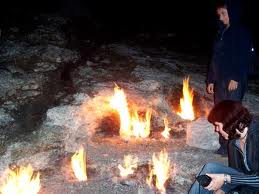It looks like you're using an Ad Blocker.
Please white-list or disable AboveTopSecret.com in your ad-blocking tool.
Thank you.
Some features of ATS will be disabled while you continue to use an ad-blocker.
3
share:
Continuing on my list of interesting places; of archaeological or mythological interest that I visited I next go to:
Yanartas
The flames burning since classical times, a methane flame from a natural source in the mountain


One of the great myths of Greeks, of a monster they called the Chimaera (Khimaira) was a fire breathing monsters part lion, goat and snake. Chimera was one of the offspring of Typhon and Echidna and a sibling of such monsters as Cerberus and the Lernaean Hydra. Like many Greek legends this has an earlier history. The pre-Hittite Chimera from Carchemish, dated to circa 800 BC, perhaps provided the basis for the Greek legend. It differs from the Greek version in that while there are three heads, none of them is that of a goat, only a main human head, a lion's head facing forward and placed on the chest of the lion's body, and a snake's head placed at the end of the tail.
The ancients placed the chimaera near a mountian in what is now southern Turkey.
Strabo noted it
Source
The location was rediscovered by the work of Captain Beaufort (of the wind 'Scale') in 1811. It was then called by the name in the OP, Yanartas or place of flames
Servius (Isidore of Seville) goes so far as to arrange these with the lions on the peak of the mountain, pastures full of goats in the middle, and serpents all about the base, thus imitating Homer's description of the monster.
So perhaps a place thought to have serpents, goats and lions - and associated with flames gave rise to it legend
Yanartas
The flames burning since classical times, a methane flame from a natural source in the mountain


One of the great myths of Greeks, of a monster they called the Chimaera (Khimaira) was a fire breathing monsters part lion, goat and snake. Chimera was one of the offspring of Typhon and Echidna and a sibling of such monsters as Cerberus and the Lernaean Hydra. Like many Greek legends this has an earlier history. The pre-Hittite Chimera from Carchemish, dated to circa 800 BC, perhaps provided the basis for the Greek legend. It differs from the Greek version in that while there are three heads, none of them is that of a goat, only a main human head, a lion's head facing forward and placed on the chest of the lion's body, and a snake's head placed at the end of the tail.
The ancients placed the chimaera near a mountian in what is now southern Turkey.
Strabo noted it
Then, next, one comes to Anticragus, a steep mountain, where is Carmylessus, an inhabited place situated in a ravine; and, after this, to Cragus, which has eight promontories and a city of the same name. The scene of the myth of Chimaera is laid in the neighborhood of these mountains. Chimaera, a ravine extending up from the shore, is not far from them. At the foot of Cragus, in the interior, lies Pinara, one of the largest cities in Lycia. Here Pandarus is held in honor, who may, perhaps, be identical with the Trojan hero, as when the poet says,“The daughter of Pandareus, the nightingale of the greenwood,
Source
The location was rediscovered by the work of Captain Beaufort (of the wind 'Scale') in 1811. It was then called by the name in the OP, Yanartas or place of flames
Servius (Isidore of Seville) goes so far as to arrange these with the lions on the peak of the mountain, pastures full of goats in the middle, and serpents all about the base, thus imitating Homer's description of the monster.
So perhaps a place thought to have serpents, goats and lions - and associated with flames gave rise to it legend
It's truly beautiful. I can see how ancient man would attribute mysterious legends to the place.
Thanks for posting....
Des
Thanks for posting....
Des
new topics
-
President BIDEN Vows to Make Americans Pay More Federal Taxes in 2025 - Political Suicide.
2024 Elections: 1 hours ago -
Ode to Artemis
General Chit Chat: 2 hours ago -
Ditching physical money
History: 5 hours ago -
One Flame Throwing Robot Dog for Christmas Please!
Weaponry: 6 hours ago -
Don't take advantage of people just because it seems easy it will backfire
Rant: 6 hours ago -
VirginOfGrand says hello
Introductions: 7 hours ago -
Should Biden Replace Harris With AOC On the 2024 Democrat Ticket?
2024 Elections: 7 hours ago -
University student disciplined after saying veganism is wrong and gender fluidity is stupid
Education and Media: 10 hours ago -
Geddy Lee in Conversation with Alex Lifeson - My Effin’ Life
People: 11 hours ago -
God lived as a Devil Dog.
Short Stories: 11 hours ago
3
